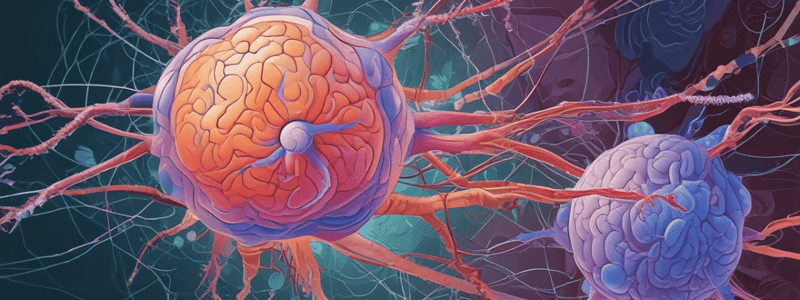Podcast
Questions and Answers
What is the primary mechanism by which signal amplification is achieved in trkA receptor signal cascades?
What is the primary mechanism by which signal amplification is achieved in trkA receptor signal cascades?
- Activating a single, highly potent signaling molecule
- Increasing the number of trkA receptors on the cell surface
- Decreasing the rate of protein degradation
- Increasing the number of active signaling molecules at each stage in a cascade (correct)
Which of the following protein kinases is NOT involved in the trkA receptor signal cascade?
Which of the following protein kinases is NOT involved in the trkA receptor signal cascade?
- PKC
- Raf-1
- Src (correct)
- PKA
What is the primary effect of CREB phosphorylation on memory formation?
What is the primary effect of CREB phosphorylation on memory formation?
- Inhibition of GABA receptors
- Increased trafficking of Kv channels
- Transcriptional regulation of gene expression (correct)
- Inhibition of glutamate receptors
What is the role of cAMP in the context of trkA receptor signal cascades?
What is the role of cAMP in the context of trkA receptor signal cascades?
What is the consequence of CREB knockout in mice?
What is the consequence of CREB knockout in mice?
Which type of receptor is involved in the D1 receptor pathway?
Which type of receptor is involved in the D1 receptor pathway?
What is the effect of protein kinase cascades on pain pathways?
What is the effect of protein kinase cascades on pain pathways?
What is the role of NGF in adults?
What is the role of NGF in adults?
Which type of receptors does NGF bind to on peripheral neurons?
Which type of receptors does NGF bind to on peripheral neurons?
What is the result of activation of one receptor by a single extracellular transmitter molecule?
What is the result of activation of one receptor by a single extracellular transmitter molecule?
What is the primary advantage of rapid on-off signals in cellular signaling?
What is the primary advantage of rapid on-off signals in cellular signaling?
Which of the following receptor classes is NOT associated with second messenger function?
Which of the following receptor classes is NOT associated with second messenger function?
What is the role of A-kinase anchoring proteins in cellular signaling?
What is the role of A-kinase anchoring proteins in cellular signaling?
Which type of protein kinase is involved in the phosphorylation of effector enzymes downstream of G-protein Coupled Receptors?
Which type of protein kinase is involved in the phosphorylation of effector enzymes downstream of G-protein Coupled Receptors?
What is the primary consequence of convergent signaling pathways on a common target?
What is the primary consequence of convergent signaling pathways on a common target?
Which of the following adenylate cyclase isoforms are activated by calcium/calmodulin?
Which of the following adenylate cyclase isoforms are activated by calcium/calmodulin?
What is the primary effect of cAMP binding to PKA?
What is the primary effect of cAMP binding to PKA?
What type of receptors are associated with adenylate cyclase activation?
What type of receptors are associated with adenylate cyclase activation?
Which of the following is a target of PKA phosphorylation?
Which of the following is a target of PKA phosphorylation?
Which subunit of PKA is responsible for cAMP binding?
Which subunit of PKA is responsible for cAMP binding?
Flashcards are hidden until you start studying
Study Notes
TrkA Receptor Signal Cascades
- TrkA receptor signal cascades amplify signals through multiple kinases, including Ras, Raf-1, PI-3-K, and PKC.
- Activation of trkA receptors leads to the activation of multiple downstream targets, including ERK1/2, Cytosolic targets, and Gene Expression.
Signal Amplification
- Signal amplification occurs by increasing the number of active signaling molecules at each stage in a cascade and using multiple pathways.
- Few primary messenger molecules can produce very diverse cellular responses.
- Signal amplification allows for sensitive and efficient signaling.
Spatio-Temporal Localisation
- cAMP influences memory formation through activation of PKA and CREB phosphorylation.
- Local [cAMP] levels influence memory formation, with short-term effects on phosphorylation and trafficking of glutamate receptors, Kv channels, and GABA receptors.
- Long-term effects occur through transcriptional regulation via CREB.
- CREB knockout mice have memory deficits and impaired patterns of neuronal hippocampal LTP firing.
Dopamine and cAMP Signaling
- Dopamine binds to D1 receptors, activating Adenylate Cyclase (AC) to produce cAMP.
- cAMP activates Protein Kinase A (PKA), which phosphorylates targets, including ion channels, enzymes, and transcription factors.
Nerve Growth Factor (NGF) and Pain
- NGF is synthesized by many different cell types and stimulates organ innervation.
- NGF drives neuronal proliferation and survival during nervous system development.
- In adults, NGF is released during tissue damage and inflammation, increasing the excitability of sensory nerves.
- NGF binds to trkA receptors on peripheral neurons, altering pain processing through altered gene expression.
Importance of Spatial and Temporal Localisation
- The rate of second messenger breakdown/removal is important for preventing unwanted signaling effects.
- Rapid on-off signals are more energetically efficient and provide greater temporal resolution.
- Spatial and temporal localisation of second messengers is important for signal specificity.
Studying That Suits You
Use AI to generate personalized quizzes and flashcards to suit your learning preferences.
